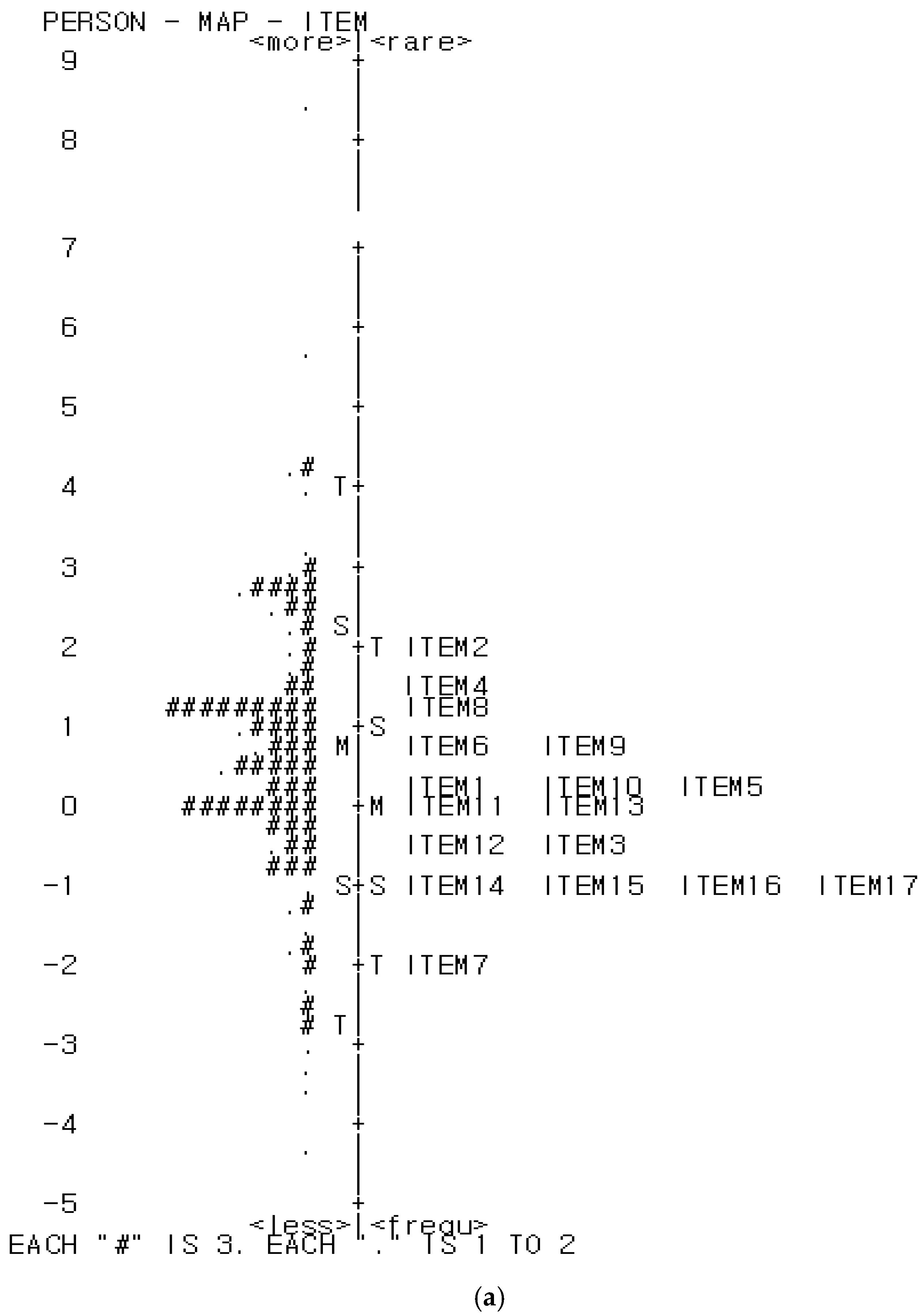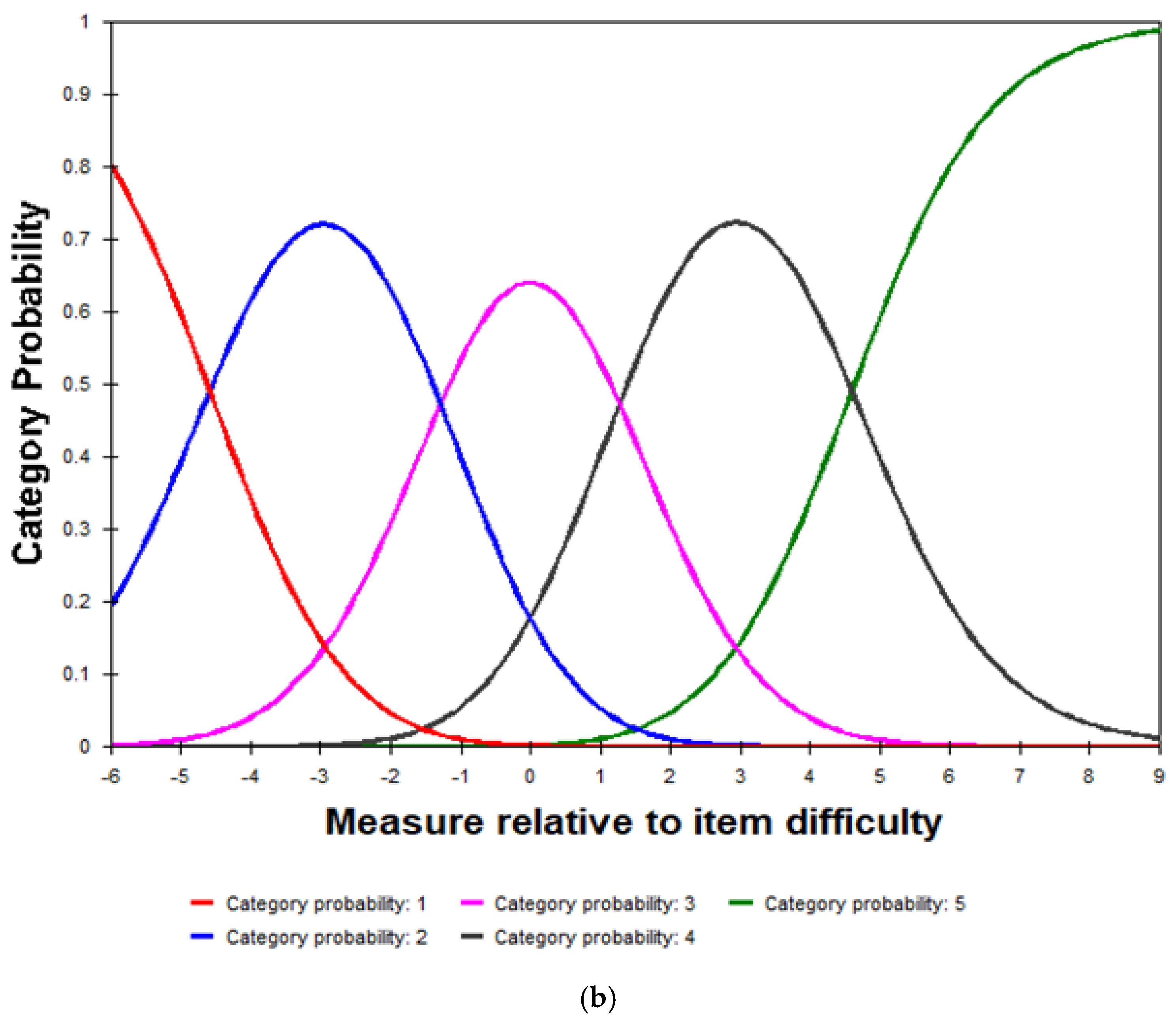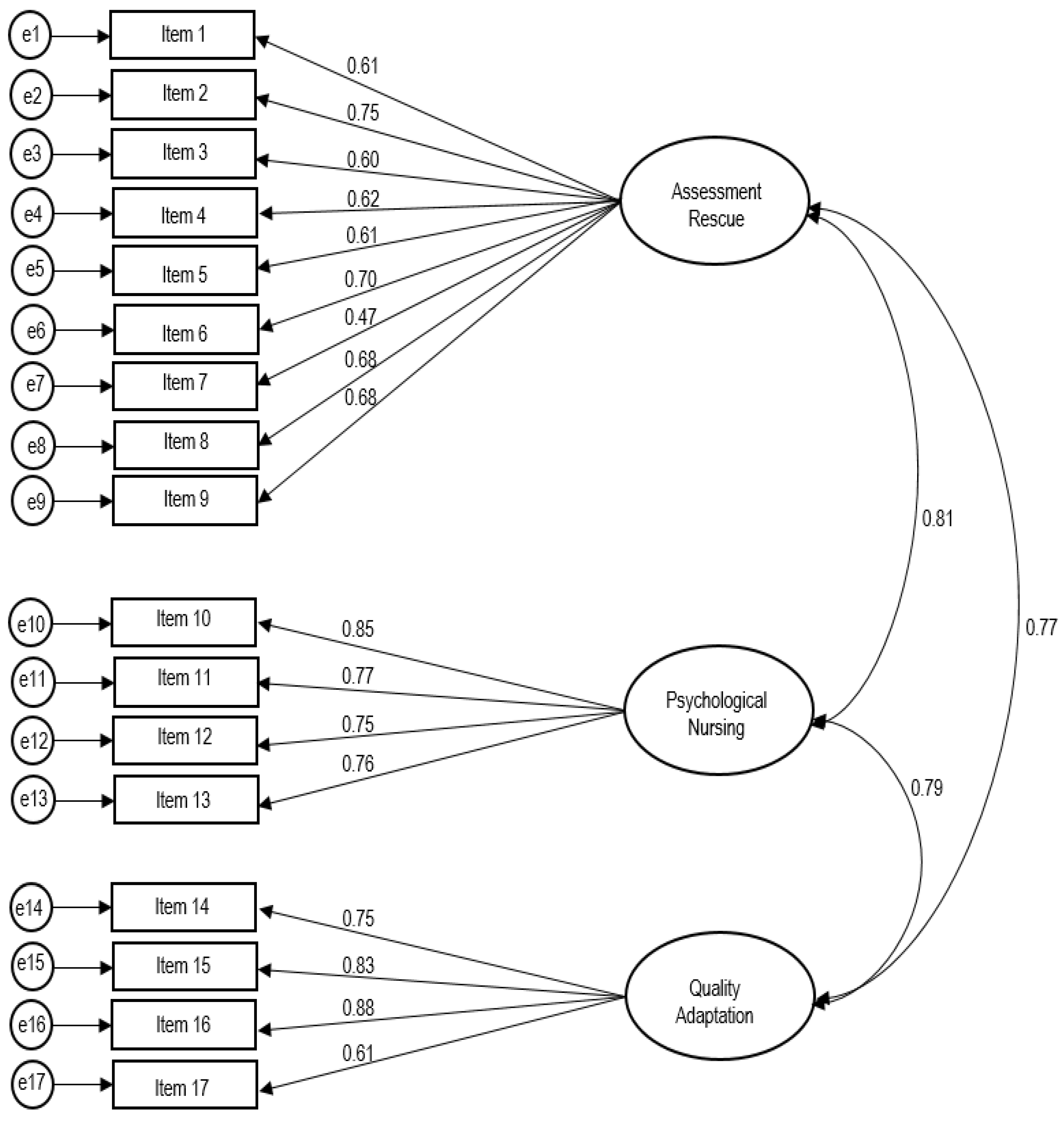A Psychometric Validation of the Korean Version of Disaster Response Self-Efficacy Scale for Nursing Students
Abstract
:1. Introduction
2. Materials and Methods
2.1. Research Design
2.2. Participants and Data Collection
2.3. Instruments
2.3.1. General Characteristics
2.3.2. The Disaster Response Self-Efficacy Scale (DRSES)
2.3.3. Korean Version of the Preparedness for Disaster Response
2.4. Scale Development Process
2.4.1. Translation/Back-Translation Phase
2.4.2. Content Validity Testing
2.4.3. Preliminary Survey
2.5. Statistical Analysis
2.5.1. Rasch Model Analysis
2.5.2. Confirmatory Factor Analysis
2.5.3. Convergent, Discriminant, and Concurrent Validity
2.5.4. Reliability
2.6. Ethical Considerations
3. Results
3.1. General Characteristics of the Study Participants
3.2. Construct Validity: Item Analysis Based on Rasch Model
3.3. Construct Validity: Confirmatory Factor Analysis
3.4. Convergent, Discriminant, and Concurrent Validity
3.5. Reliability
4. Discussion
5. Conclusions
Funding
Institutional Review Board Statement
Informed Consent Statement
Data Availability Statement
Acknowledgments
Conflicts of Interest
References
- Hung, K.K.C.; Mashino, S.; Chan, E.Y.Y.; MacDermot, M.K.; Balsari, S.; Ciottone, G.R.; Della Corte, F.; Dell’Aringa, M.F.; Egawa, S.; Evio, B.D.; et al. Health workforce development in health emergency and disaster risk management: The need for evidence-based recommendations. Int. J. Environ. Res. Public Health 2021, 18, 3382. [Google Scholar] [CrossRef]
- World Health Organization. WHO Coronavirus Disease Dashboard. Available online: https://covid19.who.int/ (accessed on 15 January 2023).
- Kim, S.H.; Kim, H.Y. Simulation-based disaster nursing education program for nursing student: A systematic review. J. Korean Soc. Simul. Nurs. 2021, 9, 69–87. [Google Scholar] [CrossRef]
- Nowell, L.; Dhingra, S.; Andrews, K.; Jackson, J. A grounded theory of clinical nurses’ process of coping during COVID-19. J. Clin. Nurs. 2021. [Google Scholar] [CrossRef]
- Goniewicz, K.; Goniewicz, M.; Burkle, F.M.; Khorram-Manesh, A. Cohort research analysis of disaster experience, preparedness, and competency-based training among nurses. PLoS ONE 2021, 16, e0244488. [Google Scholar] [CrossRef] [PubMed]
- Cusack, L.; Arbon, P.; Ranse, J. What is the role of nursing students and schools of nursing during disaster? A discussion paper. Collegian 2010, 17, 193–197. [Google Scholar] [CrossRef] [PubMed]
- World Health Organization. Integrating Emergency Preparedness and Response into Undergraduate Nursing Curricula; WHO Press: Geneva, Switzerland, 2008; pp. 1–32. [Google Scholar]
- World Health Organization; International Council of Nurses. ICN Framework of Disaster Nursing Competencies.; International Council of Nurses: Geneva, Switzerland, 2009; pp. 1–74. [Google Scholar]
- International Council of Nurses. Core Competencies in Disaster Nursing Version 2.0; International Council of Nurses: Geneva, Switzerland, 2019; pp. 1–16. [Google Scholar]
- Jung, H.M.; Kim, N.H.; Lee, Y.H.; Kim, M.S.; Kim, M.J. The effect of a disaster nursing convergence education program on disaster nursing knowledge, preparedness and self-confidence of nursing students. J. Korea Converg. Soc. 2018, 9, 377–386. [Google Scholar] [CrossRef]
- Hong, J.Y. A study on disaster nursing core competencies of nursing college students. J. Converg. Cult. Technol. 2020, 6, 199–205. [Google Scholar] [CrossRef]
- Yildiz, C.Ç.; Yildirim, D. The effects of disaster nursing education program on beliefs in general disaster preparedness, disaster response self-efficacy, and psychological resilience in nursing students: A single-blind, randomized controlled study. Nurs. Educ. Perspect. 2022, 43, 287–291. [Google Scholar] [CrossRef]
- Koca, B.; Arkan, G. The effect of the disaster management training program among nursing students. Public Health Nurs. 2020, 37, 769–777. [Google Scholar] [CrossRef] [PubMed]
- Oh, Y.J. Convergence influencing factors on disaster nursing core competencies of nursing students. J. Converg. Inf. Technol. 2022, 12, 77–84. [Google Scholar] [CrossRef]
- Ning, N.; Hu, M.; Qiao, J.; Liu, C.; Zhao, X.; Xu, W.; Xu, W.; Zheng, B.; Chen, Z.; Yu, Y.; et al. Factors associated with individual emergency preparedness behaviors: A cross-sectional survey among the public in three Chinese provinces. Front. Public. Health 2021, 9, 644421. [Google Scholar] [CrossRef]
- Cruz, J.P.; Balay-Odao, E.M.; Bajet, J.B.; Alsharari, A.F.; Tork, H.M.; Alharbi, T.A.F.; Almazan, J.U. Testing the validity and reliability of the Arabic version of the Disaster Response Self-Efficacy Scale among Saudi nursing students. Nurse. Educ. Pract. 2022, 64, 103443. [Google Scholar] [CrossRef] [PubMed]
- Adams, R.M.; Eisenman, D.P.; Glik, D. Community advantage and individual self-efficacy promote disaster preparedness: A multilevel model among persons with disabilities. Int. J. Environ. Res. Public Health 2019, 16, 2779. [Google Scholar] [CrossRef] [PubMed]
- Li, H.Y.; Bi, R.X.; Zhong, Q.L. The development and psychometric testing of a Disaster Response Self-Efficacy Scale among undergraduate nursing students. Nurse Educ. Today 2017, 59, 16–20. [Google Scholar] [CrossRef]
- Schmidt, C.K.; Davis, J.M.; Sanders, J.L.; Chapman, L.A.; Cisco, M.C.; Hady, A.R. Exploring nursing students’ level of preparedness for disaster response. Nurs. Educ. Perspect. 2011, 32, 380–383. [Google Scholar] [CrossRef] [PubMed]
- Koca, B.; Çağan, Ö.; Türe, A. Validity and reliability study of the Turkish version of the Disaster Response Self-Efficacy Scale in undergraduate nursing students. Acıbadem Üniversitesi Sağlık Bilim. Derg. 2020, 11, 515–521. [Google Scholar] [CrossRef]
- World Health Organization. Process of Translation and Adaptation of Instruments. Available online: https://www.coursehero.com/file/30372721/WHO-Process-of-translation-and-adap-tation-of-instrumentspdf/ (accessed on 15 January 2023).
- Khine, M.S. Structural Equation Modeling Approaches in Educational Research and Practice; Brill-Sense: Paderborn, Germany, 2013; pp. 277–283. [Google Scholar]
- Hair, J.F.; Anderson, R.E.; Babin, B.J.; Black, W.C. Multivariate Data Analysis: A Global Perspective, 7th ed.; Pearson Education Upper Saddle River: Hoboken, NJ, USA, 2010; pp. 1–800. [Google Scholar]
- Bond, T.G.; Fox, C.M. Applying the Rasch model: Fundamental Measurement in the Human Science, 2nd ed.; Lawrance Erlbaum Associates Publisher London: New Jersey, NJ, USA, 2007; pp. 1–360. [Google Scholar]
- Linacre, J.M. Rasch model estimation: Further topics. J. Appl. Meas. 2004, 5, 95–110. [Google Scholar]
- Kim, H.J. A study on disaster preparedness, core competencies and educational needs on disaster nursing of nursing students. J. Korea Acad. Coop. Soc. 2015, 16, 7447–7455. [Google Scholar] [CrossRef]
- Okoli, C.; Pawlowski, S.D. The Delphi method as a research tool: An example, design considerations and applications. Inf. Manag. 2004, 42, 15–29. [Google Scholar] [CrossRef]
- Ayre, C.; Scally, A.J. Critical values for Lawshe’s content validity ratio: Revisiting the original methods of calculation. Meas. Eval. Couns. Dev. 2014, 47, 79–86. [Google Scholar] [CrossRef]
- Son, J.W. Evaluation of 119 emergency medical technicians’ work related musculoskeletal disorders risk with regard to patient lifting procedures. Korean. J. Emerg. Med. Ser. 2019, 23, 101–112. [Google Scholar] [CrossRef]
- Davidson, P. Now is the time for new nursing scholarship: A post COVID-19 reset. In Proceedings of the 32nd International Nursing Research Congress 2021 of Sigma Theta Tau International, Virtual, 21–23 July 2021. [Google Scholar]
- Ab Hamid, M.R.; Sami, W.; Sidek, M.M. Discriminant validity assessment: Use of Fornell & Larcker criterion versus HTMT criterion. J. Phys. Conf. Ser. 2017, 890, 012163. [Google Scholar] [CrossRef]
- Gonzalez, C.M.; Grochowalski, J.H.; Garba, R.J.; Bonner, S.; Marantz, P.R. Validity evidence for a novel instrument assessing medical student attitudes toward instruction in implicit bias recognition and management. BMC Med. Educ. 2021, 21, 205. [Google Scholar] [CrossRef]
- Lee, J.; Lee, E. The Effects of disaster training education on the attitudes, preparedness, and competencies in disaster nursing of hospital nurses. J. Korean Acad. Community Health Nurs. 2020, 31, 491–502. [Google Scholar] [CrossRef]
- Lee, E.H.; Kim, C.J.; Kim, E.J.; Chae, H.J.; Cho, S.Y. Measurement properties of self-report questionnaires published in Korean nursing journals. J. Korean Acad. Nurs. 2013, 43, 50–58. [Google Scholar] [CrossRef] [PubMed]
- Shin, H.S.; Chi, E.; Han, H.R. Validity and reliability of the Korean version of assessment of health literacy in breast and cervical cancer screening. J. Korean Acad. Nurs. 2021, 51, 769–781. [Google Scholar] [CrossRef]
- Korean Accreditation Board of Nursing. Report on Validity of Accreditation for Nursing Education Program. Available online: http://old.kabone.or.kr/HyAdmin/upload/goodFile/120210915082357.pdf (accessed on 15 January 2023).
- Shiomitsu, Y.; Yamaguchi, T.; Imamura, K.; Koyama, T.; Tsuchihashi, H.; Kawaoka, Y.; Matsunari, Y. A Comparison of the contents of disaster nursing practices and perceived difficulties among nurses working at welfare evacuation shelters during natural disasters and multiple disasters: A qualitative study. Int. J. Environ. Res. Public Health. 2022, 19, 16610. [Google Scholar] [CrossRef] [PubMed]
- Han, S.J.; Cho, C.M.; Lee, Y.R.; Nagasaka, K.; Izummune, M.; Lee, S.B.; Lee, J.H. A content analysis of disaster nursing education in Korean and Japanese universities. J. Korean Acad. Community Health Nurs. 2019, 30, 307–323. [Google Scholar] [CrossRef]
- Yamamoto, A. Development of disaster nursing in Japan, and trends of disaster nursing in the world. Jpn. J. Nurs. Sci. 2013, 10, 162–169. [Google Scholar] [CrossRef]
- Jung, E.Y.; Kim, H.W.; Joe, S.Y. Current state of disaster education in undergraduate nursing programs in South Korea. Korean J. Mil. Nurs. Res. 2018, 36, 106–119. [Google Scholar] [CrossRef]



| Characteristics | Categories | N (%) | |
|---|---|---|---|
| Age (years) | 23.19 ± 2.92 | ||
| Gender | Male | 27 | (12.9) |
| Female | 182 | (87.1) | |
| Academic year | Senior | 209 | (100) |
| Experience in | Yes | 114 | (54.5) |
| disaster education | No | 95 | (45.5) |
| Necessity of | Yes | 205 | (98.1) |
| disaster nursing education | No | 4 | (1.9) |
| Willingness of | Yes | 201 | (96.2) |
| disaster nursing education | No | 8 | (3.8) |
| Items | Measure | Infit MNSQ | Outfit MNSQ | PT-Measure CORR. |
|---|---|---|---|---|
| 1. Detect the relative harm from the disaster | 0.37 | 1.06 | 1.03 | 0.63 |
| 2. Assess injuries accurately and swiftly | 2.09 | 0.85 | 0.84 | 0.72 |
| 3. Recognize vulnerable populations, such as chronic patients or disabled people | −0.39 | 1.06 | 1.08 | 0.62 |
| 4. Triage technique | 1.58 | 1.11 | 1.10 | 0.59 |
| 5. Hemostasis, bandaging, and splinting | 0.15 | 1.22 | 1.22 | 0.58 |
| 6. Transfer care | 0.78 | 1.00 | 0.98 | 0.67 |
| 7. Emergency rescue techniques (BLS) | −1.99 | 1.29 | 1.33 | 0.41 |
| 8. Intensive care and nursing of critically ill patients | 1.16 | 1.08 | 1.09 | 0.65 |
| 9. Prevention and control of infectious diseases in disaster area | 0.78 | 0.99 | 0.99 | 0.66 |
| 10. Initial psychological assessment of disaster victims | 0.13 | 0.79 | 0.78 | 0.75 |
| 11. Recognize common psychiatric and psychological problems after disaster, such as PTSD, depression, and anxiety | −0.06 | 1.07 | 1.04 | 0.65 |
| 12. Provide basic psychological intervention for disaster victims | −0.62 | 0.94 | 0.95 | 0.68 |
| 13. Referral of victims who need psychiatric and psychological treatment in the disaster area | 0.08 | 0.87 | 0.88 | 0.75 |
| 14. Adjust one’s own psychological state and adapt to the working environment quickly | −1.01 | 0.97 | 0.98 | 0.69 |
| 15. Communicate with other team professionals and establish good cooperation relationship | −1.07 | 0.87 | 0.89 | 0.71 |
| 16. Actively communicate with victims and relatives and establish good nurse-patient relationship | −1.07 | 0.67 | 0.66 | 0.78 |
| 17. Obey professional ethics with humanitarian and full of empathy and love | −0.90 | 1.10 | 2.79 | 0.59 |
| Model | r | p | 95% CI | |
|---|---|---|---|---|
| Lower CI | Upper CI | |||
| Assessment and rescue—Psychological nursing | 0.695 | < 0.001 | 0.681 | 0.759 |
| Assessment and rescue—Quality adaptation | 0.686 | < 0.001 | 0.607 | 0.752 |
| Psychological nursing—Quality adaptation | 0.675 | < 0.001 | 0.594 | 0.743 |
Disclaimer/Publisher’s Note: The statements, opinions and data contained in all publications are solely those of the individual author(s) and contributor(s) and not of MDPI and/or the editor(s). MDPI and/or the editor(s) disclaim responsibility for any injury to people or property resulting from any ideas, methods, instructions or products referred to in the content. |
© 2023 by the author. Licensee MDPI, Basel, Switzerland. This article is an open access article distributed under the terms and conditions of the Creative Commons Attribution (CC BY) license (https://creativecommons.org/licenses/by/4.0/).
Share and Cite
Kim, S.H. A Psychometric Validation of the Korean Version of Disaster Response Self-Efficacy Scale for Nursing Students. Int. J. Environ. Res. Public Health 2023, 20, 2804. https://doi.org/10.3390/ijerph20042804
Kim SH. A Psychometric Validation of the Korean Version of Disaster Response Self-Efficacy Scale for Nursing Students. International Journal of Environmental Research and Public Health. 2023; 20(4):2804. https://doi.org/10.3390/ijerph20042804
Chicago/Turabian StyleKim, Sung Hae. 2023. "A Psychometric Validation of the Korean Version of Disaster Response Self-Efficacy Scale for Nursing Students" International Journal of Environmental Research and Public Health 20, no. 4: 2804. https://doi.org/10.3390/ijerph20042804
APA StyleKim, S. H. (2023). A Psychometric Validation of the Korean Version of Disaster Response Self-Efficacy Scale for Nursing Students. International Journal of Environmental Research and Public Health, 20(4), 2804. https://doi.org/10.3390/ijerph20042804







